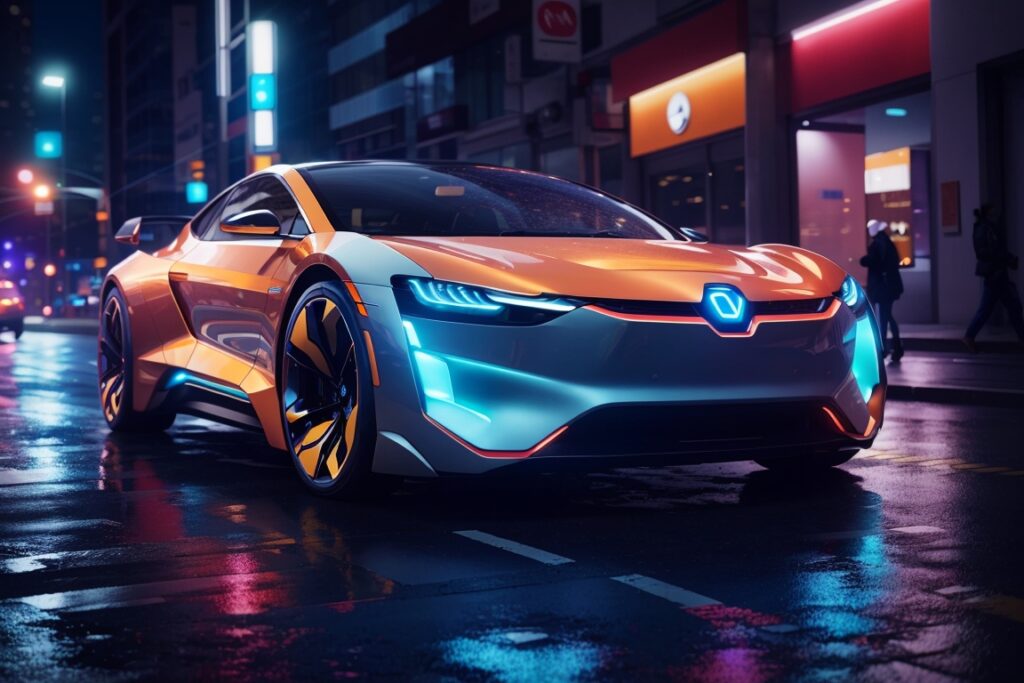

Artificial Intelligence (AI) and autonomous vehicles are two cutting-edge technologies that have the potential to revolutionize the way we travel and commute. AI is a branch of computer science that focuses on creating intelligent machines capable of performing tasks that typically require human intelligence. On the other hand, autonomous vehicles are vehicles capable of driving themselves without the need for human input. In this article, we will explore the role of AI in building infrastructure for autonomous vehicles, the growth of AI in the automotive industry, the use of AI and machine learning in self-driving cars, AI applications in autonomous vehicles, and the challenges and benefits of AI in this field.
Introduction to AI and Autonomous Vehicles
What is Artificial Intelligence?
Artificial Intelligence refers to the simulation of human intelligence in machines that are programmed to think and learn like humans. It involves the development of intelligent systems that can perceive their environment, reason, learn from past experiences, and make decisions based on that knowledge. AI encompasses a wide range of technologies, including machine learning, natural language processing, computer vision, and robotics, among others.
What are Autonomous Vehicles?
Autonomous vehicles, also known as self-driving cars or driverless cars, are vehicles that can operate and navigate without human input. These vehicles are equipped with various sensors, such as cameras, radar, and lidar, which gather information about the vehicle’s surroundings. The information collected by these sensors is then processed by AI algorithms to make decisions and control the vehicle. Autonomous vehicles have the potential to reduce accidents, increase transportation efficiency, and improve mobility.
Role of AI in Building Infrastructure for Autonomous Vehicles
AI plays a crucial role in building the infrastructure necessary for the widespread adoption of autonomous vehicles. The development of AI algorithms that can process and interpret sensor data is essential for autonomous vehicles to navigate safely and make informed decisions. AI also enables vehicles to interact with other vehicles and infrastructure through vehicle-to-vehicle (V2V) and vehicle-to-infrastructure (V2I) communication systems. These systems allow autonomous vehicles to communicate with each other and with road infrastructure, such as traffic lights and road signs, to enhance safety and efficiency on the road.
The Growth of AI in Autonomous Vehicle Industry

The Importance of AI in the Automotive Industry
AI has become increasingly important in the automotive industry due to the growing demand for autonomous vehicles. AI enables vehicles to perceive their environment, understand traffic situations, and make decisions in real-time, making them safer and more efficient than traditional vehicles. The integration of AI in autonomous vehicles also opens up opportunities for innovative transportation services, such as ride-sharing and on-demand mobility solutions, which can transform the way we travel.
AI Perception Action Cycle in Autonomous Vehicles
Autonomous vehicles rely on a perception-action cycle enabled by AI algorithms. The perception phase involves the collection of data from various sensors, such as cameras, radar, and lidar, to create a detailed understanding of the vehicle’s surroundings. This data is then processed and analyzed by AI algorithms to make informed decisions in real-time. The action phase involves executing the decisions made by AI algorithms to control the vehicle, such as accelerating, braking, and steering. This perception-action cycle allows autonomous vehicles to navigate safely and efficiently.
Future of Autonomous Driving and AI Regulation
The future of autonomous driving and AI regulation is closely intertwined. As autonomous vehicles become more common on our roads, there is a need to establish regulations and standards to ensure safety and reliability. AI algorithms used in autonomous vehicles need to be transparent and accountable, and they should be capable of adapting to different driving conditions and scenarios. Additionally, AI regulation should address ethical considerations, such as the decision-making process in life-or-death situations. It is crucial for governments and regulatory bodies to work closely with AI developers and automotive companies to establish guidelines that promote the responsible and safe use of AI in autonomous vehicles.
AI and Machine Learning in Self-Driving Cars
How Does AI Work in Autonomous Vehicles?
AI algorithms in autonomous vehicles work by processing data from various sensors, analyzing it, and making decisions based on that information. These algorithms are designed to handle complex driving tasks, such as lane detection, object recognition, and decision-making in real-time. AI enables autonomous vehicles to perceive their environment, understand traffic patterns, and navigate safely on the road.
Machine Learning Algorithms Used by Self-Driving Cars
Machine learning algorithms are an integral part of AI in autonomous vehicles. These algorithms allow vehicles to learn from data and improve their performance over time. Supervised learning algorithms are commonly used in autonomous driving, where the algorithm is trained using a labeled dataset. Unsupervised learning algorithms, on the other hand, are used to discover patterns and relationships in data without the need for labeled examples. Reinforcement learning algorithms can also be used to enable autonomous vehicles to learn from their own experiences through trial and error.
Supervised vs Unsupervised Learning in Autonomous Driving
Supervised learning and unsupervised learning have different applications in autonomous driving. Supervised learning is used to train AI algorithms to recognize objects, such as pedestrians, vehicles, and road signs, based on labeled examples. Unsupervised learning, on the other hand, is used to discover patterns and relationships in data without the need for labeled examples. It can be used to analyze sensor data and detect anomalies or unusual behavior on the road.
Generative AI and its Role in Self-Driving Cars
Generative AI is a field of AI that focuses on creating models capable of generating new, realistic data. In the context of self-driving cars, generative AI can be used to generate synthetic data that simulates various driving scenarios. This synthetic data can then be used to train AI algorithms and improve their performance. Generative AI has the potential to enhance the training process of autonomous vehicles by providing a diverse and comprehensive dataset that covers a wide range of driving conditions and scenarios.

AI Applications in Autonomous Vehicles
AI Perception in Self-Driving Cars
AI perception is a fundamental aspect of autonomous vehicles. It involves the ability of AI algorithms to perceive and understand the vehicle’s surroundings using data from sensors, such as cameras, radar, and lidar. AI perception enables self-driving cars to detect and recognize objects, such as pedestrians, vehicles, and road signs, and make decisions based on that information. This capability allows autonomous vehicles to navigate safely and avoid obstacles on the road.
The Role of AI in Data Generation for Autonomous Vehicles
AI plays a crucial role in data generation for autonomous vehicles. AI algorithms can generate synthetic data that simulates a wide range of driving scenarios, allowing autonomous vehicles to train and improve their performance. This synthetic data includes various environmental factors, such as different weather conditions, road types, and traffic situations. By training on a diverse dataset, autonomous vehicles can learn to handle different driving conditions and make informed decisions in real-time.
AI Algorithms for Object Recognition and Data Classification
AI algorithms are used for object recognition and data classification in autonomous vehicles. These algorithms analyze sensor data, such as images and radar signals, to detect and recognize objects, such as pedestrians, vehicles, and road signs. This information is then used to make decisions and control the vehicle. AI algorithms for object recognition and data classification are continuously evolving and improving, allowing autonomous vehicles to accurately perceive their environment and navigate safely on the road.
The Importance of AI in Making Life-or-Death Decisions for Autonomous Vehicles
One of the most challenging aspects of autonomous driving is the ability to make life-or-death decisions in critical situations. AI algorithms play a crucial role in this aspect by analyzing sensor data, assessing the surrounding environment, and making decisions in real-time. For example, when faced with a potential collision, AI algorithms can analyze various factors, such as the speed and trajectory of the vehicle and the presence of pedestrians, to determine the best course of action, such as braking or swerving. AI enables autonomous vehicles to make split-second decisions that prioritize the safety of all road users.

Challenges and Benefits of AI in Autonomous Vehicles
Addressing Challenges in AI and Autonomous Driving
AI and autonomous driving face several challenges that need to be addressed to ensure their widespread adoption. One of the main challenges is the development of robust and reliable AI algorithms that can handle complex driving scenarios and unpredictable situations. Testing and validation of AI systems in various real-world conditions is crucial to ensure their safety and performance. Other challenges include regulatory and legal frameworks, cybersecurity risks, and public acceptance of autonomous vehicles.
The Pros and Cons of AI in Self-Driving Cars
AI in self-driving cars has both pros and cons. On the one hand, AI enables autonomous vehicles to navigate safely, reduce accidents, and improve overall transportation efficiency. It has the potential to revolutionize transportation and provide mobility solutions for people who cannot drive, such as the elderly and people with disabilities. On the other hand, challenges such as ethical decision-making and cybersecurity risks need to be addressed. Additionally, the integration of AI in autonomous vehicles may lead to job displacement in the transportation industry, which needs to be managed appropriately.
Making Vehicles Safer and Reducing Human Error with AI
One of the main benefits of AI in autonomous vehicles is the potential to make vehicles safer and reduce human error on the road. According to the National Highway Traffic Safety Administration (NHTSA), human error is a contributing factor in 94% of accidents. AI technology, such as advanced driver-assistance systems (ADAS) and autonomous driving, can help prevent accidents by detecting potential risks, such as sudden braking or lane drifting, and taking corrective actions in real-time. AI algorithms can also analyze data from multiple sensors and predict potential hazards, reducing the risk of accidents caused by human error.
Conclusion
The integration of AI in autonomous vehicles has the potential to transform the way we travel and commute. AI enables vehicles to perceive their environment, make informed decisions, and navigate safely on the road. The growth of AI in the automotive industry and its applications in autonomous vehicles are opening up opportunities for innovative transportation solutions, increased safety, and improved mobility. However, challenges related to regulation, ethics, and public acceptance need to be addressed to ensure the responsible and safe use of AI in autonomous vehicles. The future of autonomous driving and AI regulation relies on collaboration between governments, regulatory bodies, AI developers, and automotive companies to shape a future where AI and autonomous vehicles coexist harmoniously.
FAQ for Autonomous Vehicles using A.I.

Q: What is artificial intelligence and how is it related to autonomous vehicles?
A: Artificial intelligence (AI) refers to the ability of a computer system to mimic human intelligence and perform tasks that typically require human intelligence. In the context of autonomous vehicles, AI is used to develop algorithms and systems that enable cars to function without human intervention.
Q: How is artificial intelligence used in the automotive industry?
A: Artificial intelligence is used in the automotive industry to develop algorithms and systems that enable autonomous driving. These algorithms help in perception, decision-making, and control of the vehicle, allowing it to analyze and respond to its surroundings in real-time.
Q: What are automotive artificial intelligence algorithms?
A: Automotive artificial intelligence algorithms are mathematical instructions that allow autonomous vehicles to process and analyze data from various sensors, such as cameras, lidars, and radars. These algorithms help the vehicle perceive its surroundings, make decisions, and control its movements.
Q: How do autonomous cars work?
A: Autonomous cars use a combination of sensors, algorithms, and artificial intelligence to perceive their surroundings, make decisions, and control their movements. These vehicles rely on sensory input from cameras, lidars, radars, and other sensors to analyze the environment and navigate safely.
Q: What role does AI play in autonomous driving?
A: AI plays a crucial role in autonomous driving by enabling vehicles to perceive their surroundings, make intelligent decisions, and control their movements. AI algorithms analyze sensor data, recognize objects, predict their behavior, and plan the vehicle’s actions accordingly.
Q: Can AI eliminate human errors in driving?
A: AI has the potential to reduce human errors in driving by providing advanced driver assistance systems and enabling autonomous driving. With AI algorithms analyzing and reacting to the driving environment, the chances of human error can be minimized, leading to safer roads.
Q: What is the future of autonomous driving?
A: The future of autonomous driving is expected to see further advancements in AI technology, leading to fully autonomous vehicles on the roads. With continued research and development, autonomous vehicles have the potential to revolutionize transportation and make it safer and more efficient.
Q: How is artificial intelligence regulated in autonomous vehicles?
A: Artificial intelligence in autonomous vehicles is regulated by various governmental and industry bodies. These regulations aim to ensure the safe and responsible use of AI in autonomous systems, including guidelines on testing, cybersecurity, and ethical considerations.
Q: How do self-driving cars use artificial intelligence?
A: Self-driving cars use artificial intelligence algorithms to perceive their surroundings, make decisions, and control their movements. AI algorithms analyze sensor data, recognize objects, interpret road signs and traffic signals, and navigate the vehicle safely to its destination.
Q: What is the relationship between deep learning and autonomous driving?
A: Deep learning, a subfield of artificial intelligence, plays a crucial role in autonomous driving. Deep learning algorithms, specifically neural networks, can analyze vast amounts of data and learn complex patterns, enabling autonomous vehicles to understand and respond to various driving situations.
